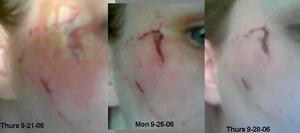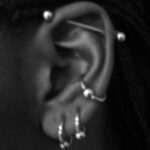Scars are a natural way the body heals its wounds. You might not have known that there are different types of scars that can develop. A hypertrophic scar is one that has healed with excess tissue. Many people get these types of scars confused with keloid scars. According to Emedicine.Medscape.com, the “difference between a keloid and a hypertrophied scar is that a keloid continues to enlarge beyond the original size and shape of the wound, while a hypertrophied scar enlarges within the confines of the original wound. Although both can be red and raised, keloids continue to grow and hypertrophied scars tend to regress over time. Both can recur after surgical excision; however, the recurrence of keloid scars is more common.”
Hypertrophic scars are more common than keloid scars and are unique to humans. They are made of connective tissue and are thicker than normal skin and usually darker than the surrounding skin as well, and they can develop at any time, even after the healing process for the wounded area has ended. These types of scars can form on a person of any age, any race, any origin, etc., meaning they are not specific to a certain demographic of the population, but they do tend to form in areas of the body that feature taut skin where tension is greater or in movement-dependent or pressure-dependent areas, such as the upper back, shoulders, lower face, and the front of the chest, for a few examples. These types of scars are formed when either there is an increase in collagen, or fiber-rich protein, or a decrease in the collagen deterioration. These types of scars could run in your family, so you may be genetically prone to developing this type of scar. Wound infection and wound orientation different from the relaxed skin tension lines can also bring about the formation of hypertrophic scars. They can be red, raised, painful, and/or itchy for some people. Some people may also experience nerve damage or loss of sensation in the scar area.
“Those with a family history of hypertrophic scars have more chances of developing such scars and even after attempts of removal, the chances of them returning and forming again are more,” as stated on the 247surgery website. There are several treatments available for those who have developed hypertrophic scars. Certain methods of massage on the area and the scar itself once it has healed is effective in breaking up some of the thickened tissue that has formed. Also, there are special gels and ointments that can be applied while the scar is still healing that claim to lessen the scar tissue formation.
Steroid injections have shown positive results for some patients with hypertrophic scars. More dramatically, if you have the money or your insurance will cover it, you can undergo laser treatment to lessen the appearance of the scar. This type of treatment most often lightens the scar, and sometimes removes all traces of the scar completely, so it’s usually the most effective treatment. On the other hand, there is a chance of the scar recurring after this surgical treatment.
Abnormal scars can occur on anyone. There are different types of scars that can develop. Hypertrohic scars are a type that may be spotted and noticed more often on people because they tend to be thick and sometimes raised and red or discolored from the rest of the skin. Anyone can develop this type of scar. There are different treatment options to diminish the appearance of this kind of scar, from massages and ointments to steroid injections and surgery options. If you have this type of scar and it’s something that bothers you, check with your doctor and insurance company to see if it is something that can be treated and paid for by your insurance.
Sources:
http://emedicine.medscape.com/article/1298541-overview
http://www.burnsurvivorsttw.org/articles/hyper.html
http://www.blainelabs.com/article-hypertrophic-scar.php
http://www.247surgery.com/hypertrophicscars.html



